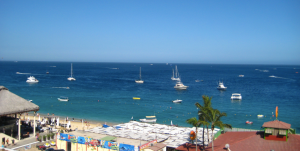Review of “Capable Cruiser, 3rd Edition” by Lin and Larry Pardey
Review of “Capable Cruiser”, 3rd Edition
by Lin and Larry Pardey
“Capable Cruiser, 3rd Edition” is the Pardey’s ninth book, and is the compilation of more than forty years of experience in boat construction, sailing, cruising and seamanship. This legendary couple, winners of the 2009 Cruising Club of America Far Horizon’s Award, share their philosophy of cruising and lessons learned from four decades of sailing the world in Taleisin, their engineless 27 feet, 6 inches wooden boat. For those of you who have never before had the pleasure of reading their work, Capable Cruiser, 3rd Edition takes you from their beginnings to the present and introduces you, by way of the Pardey’s simple lifestyle, to the basics of cruising.

Cabo San Lucas June, 2010, site of the 1982 anchorage disaster reviewed by the Pardeys in "Capable Cruiser, 3rd Edition"
Many chapters are completely new while some include writings from the past, updated to the present. Some of the chapters seem out of place until the reader realizes the Pardeys are intent on sharing the most important lessons they have learned from world cruising. As a result of this any sense of disjointed editing is soon forgiven. The Pardey’s review of anchor drag risk after the Cabo San Lucas disaster of 1982 is an example of the quality of their writing. This piece never ceases to be informative and has stood the test of time (we thank loyal NFTB reader Aimee Miles for the photograph at right).
Perhaps the greatest compliment I can give to this book is to share the effect it had on our first boating trip this season. Simply put, despite a lack of wind we sailed instead of motoring. Our schedule was left “open”. High-tech took a back seat to simple basics. The result was peaceful rediscovery.
If you discovered boating aboard a small, simple vessel, this book is likely to reignite your interests and passion for boating. For those looking for a more practical result what follows are some of the lessons taught, in no particular order of importance, throughout Capable Cruiser’s pages.
- Boating doesn’t need to be high tech. What matters in a cruising package are a sound vessel and a crew that practices good seamanship.
- Research thoroughly before you purchase boating items. If you buy what you need and do so thoughtfully, you’ll have enough money left over to go cruising.
- Sailboats don’t need engines, and may even be safer without them. Not having an engine forces sailors to understand natural forces and to be skillful and prepared.
- A crew of four (4) is safest during storm conditions on any vessel greater than 37 feet.
- An anchored boat’s best chance of avoiding severe damage during a squall is to leave its anchorage and head for sea prior to high winds. Get away from a lee shore before bad weather arrives.
- The Pardeys discuss ideal ground tackle, based on their personal experience and their analysis of the 1982 Cabo San Lucas anchorage disaster. Their recommendations are carefully documented in a chapter that deals solely with ground tackle.
- Land is not a boats friend. Boats are safest far from land. If possible, move into areas near land only during favorable conditions.
- A sailboat’s engine can fail. When motoring it is prudent to have a halyard attached and be prepared to raise enough sail to avoid trouble if the engine stops.
- Less-cared-for parts of a boat, like its galvanized chain and the sail’s stitching, will last significantly longer with simple maintenance.
- And perhaps the most immediately practical information is the Pardey’s discussion of anchoring etiquette. Who knew the admiralty law case reference that requires a boater to alert his/her new neighbor if the latter’s anchorage will either interfere with the swinging room of the first to arrive or the first boat’s ability to safely maneuver out of the anchorage. FYI the U.S. Admiralty Court, in the Juniata decision (no. 124-5861), found that “A Vessel shall be found at fault if it…anchors so close to another vessel as to foul her when swinging, or if it fails to shift anchorage when dragging dangerously close to another anchored vessel. Furthermore, the vessel that anchored first shall warn the one who anchored last that the berth chosen will foul the former’s berth”. This case appears to create an affirmative duty on the part of the first boat in an anchorage to inform a newcomer if swinging room or a safe exit route is impaired. Now you know.
Capable Cruiser, 3rd Edition is worth reading. Some of the Pardey’s advice is specific to cruising while much applies to life in general. In today’s high tech, fast moving world it is heartwarming and refreshing to rediscover, through the eyes of a couple who have “lived the dream”, life’s simplest qualities.